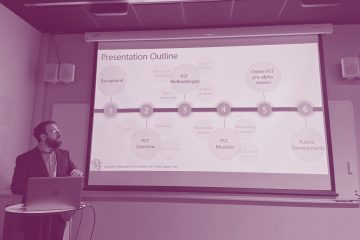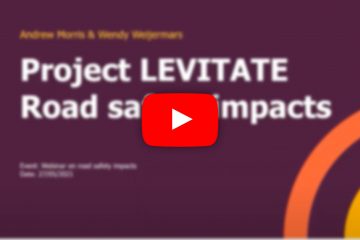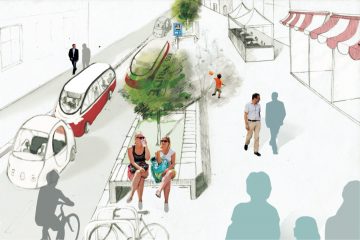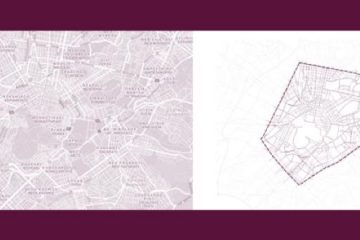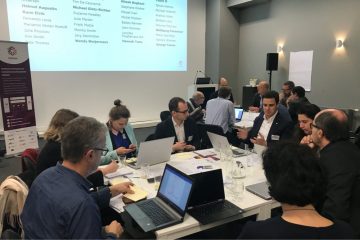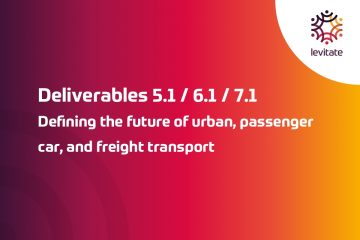Questions to Wendy Weijermars, SWOV – Institute for Road Safety Research
Q: Please, introduce yourself shortly: what do you do at SWOV and what is your role in the project?
A: Hi, I am Wendy. I am a traffic engineer by education and I work at SWOV for more than thirteen years now. At SWOV I have been involved in a wide variety of projects, for example on road safety forecasts, safety at road work zones, safety performance indicators for roads, projects related to the safe system approach/sustainable safety and studies focussing on serious road injuries. Since July last year, I am research manager of the department ‘infrastructure and traffic’.
Within LEVITATE, I coordinate the SWOV activities and the work related to estimation of road safety impacts. In addition, I lead the Work Package that deals with the ethical requirements that the project must comply with.
I am not the only person from SWOV that is involved in LEVITATE! Other SWOV colleagues that are or have been involved in LEVITATE are (in alphabetic order): Atze Dijkstra, Celina Mons, Diane Cleij, Ellen van der Hijden, Frits Bijleveld, Govert Schermers, Jan Hendrik van Petegem, Lucas Raggers, Kas Kamphuis, Marijke Tros, Michelle Doumen, Rins de Zwart and last but not least Sanne van Gils.
Q: As a partner, how do you contribute to LEVITATE and why did you join the project?
A: SWOV has been involved in many European projects and LEVITATE is not comparable to any of them. At first sight, LEVITATE might not seem the most logical project for SWOV to be involved in, as SWOV focuses on road safety research whereas LEVITATE has a much broader scope dealing with all kinds of impacts of Connected and Automated Transport Systems (CATS). Nevertheless, LEVITATE is a very interesting and relevant project for SWOV. We expect CATS to have an enormous impact on (urban) traffic and subsequently also on road safety. Moreover, as different impacts -including road safety- are interrelated, they should not be analysed in isolation but all together at the same time. That is one of the main strengths of LEVITATE, in my view. Moreover, LEVITATE gives us the opportunity to do multidisciplinary research with a great team of international partners.
Naturally, SWOV is heavily involved in the estimation of the road safety impacts. As part of these activities we planned to carry out a driving simulator experiment to examine how human drivers adapt their driving behaviour when surrounded by CATS. We will have to wait and see when the circumstances allow us to run this experiment.
SWOV is also involved in other parts of the project. We were for example in charge of the development of communication tools like the project identity, including the project leaflet. Moreover, SWOV hosts the LEVITATE website and distributes the newsletters. We were also involved in developing the framework that shows how the different impact are related to each other, just to name a few.
Q: At SWOV, you mostly work on road safety, how do you think LEVITATE will contribute to a safer mobility?
A: My short answer is that LEVITATE can contribute to a safer mobility by better informing policy makers about the road safety impacts of their decisions in relation to CATS.
I think that CATS can have the potential to substantially increase safety. However, the actual safety impacts of CATS heavily depend on choices of policy makers concerning the introduction and regulation of CATS but also concerning for example the provision of dedicated lanes. To be able to take the appropriate measures at the right time, policy makers need to be well informed, i.e. they need to be able to estimate the impacts of CATS as well as the impacts of different policy decisions.
That is exactly our ambition within LEVITATE. The Policy Support Tool (PST) that we are developing aims to enable policy makers and other stakeholders to estimate short, medium and long-term impacts of CATS and to establish the most effective policy pathways for the introduction of CATS to achieve predefined objectives.
Q: What would you mention as biggest risks for the project to deliver what it promised?
A: In my view, LEVITATE is a very ambitious and therefore also a very challenging project. First of all, it is very difficult to forecast what is going to happen in the future; who could have forecasted the drop in international travel due to COVID two years ago. Developments like CATS are particularly difficult to predict, as these developments cannot be forecasted by extrapolating past trends and are highly dependent on for example public acceptance. It is highly uncertain when and even if fully automated (level 5) vehicles will be dominating urban traffic.
Second, CATS have all kinds of impacts on (urban) traffic and beyond (e.g. land use) and these impacts are also interrelated and depending on policy decisions and other factors. As the impacts are interrelated, they ideally should be forecasted all together at the same time. Preferably, use cases (urban transport, passenger vehicles and freight transport) should also be analysed all together, as well as possible combinations of interventions.
It is very challenging to forecast all kinds of impacts of CATS in a way in which all interrelations are taken into account and to also implement this in a user friendly PST that can be used by policy makers. Therefore, we will have to make some assumptions and the PST will have some limitations. I think it is important to be very clear about these assumptions and limitations.
Q: Do you think, connected and automated vehicles will change the way how we manage mobility nowadays? If yes, in which way?
A: I think CATS could have an enormous impact on how we manage mobility. To start with, they could have large impacts on mobility patterns of citizens. CATS could also for example lead to less active mobility as urban shuttles might attract people that currently walk or cycle and people without a driving licence will probably be able to drive an automated car. Moreover, I think travel time will be valued differently so people might decide to work further from home. However, policy makers can influence the impacts of CATS by all kinds of policy interventions like regulation, road pricing and economic incentives.
I expect CATS to also have an impact on the use of public space in the city. One might for example not need parking spaces in the city centre anymore as cars could drive themselves to a less crowded place. On the other hand, one might need more places were cars or urban shuttles can drop off or pick up their passengers.


